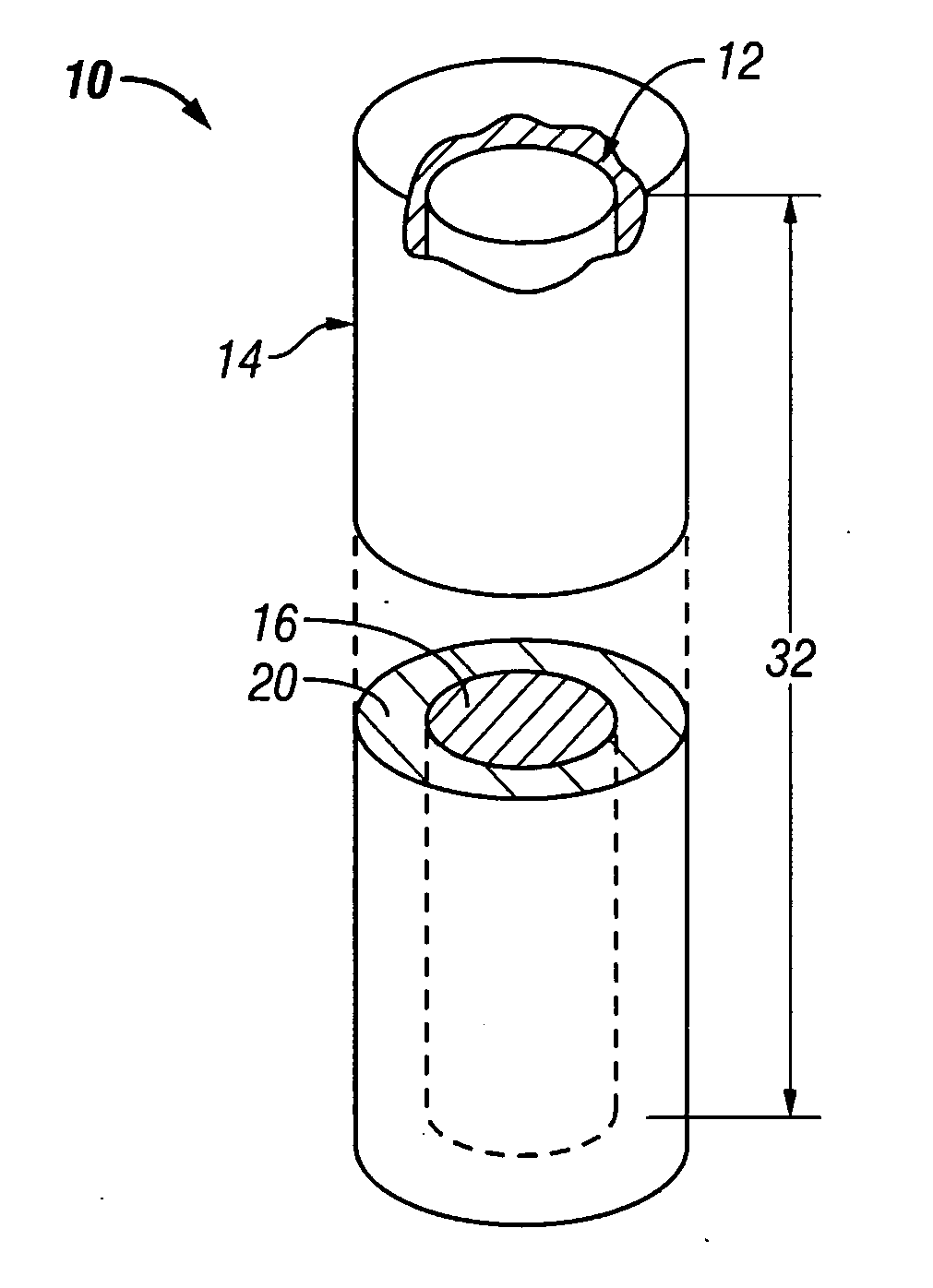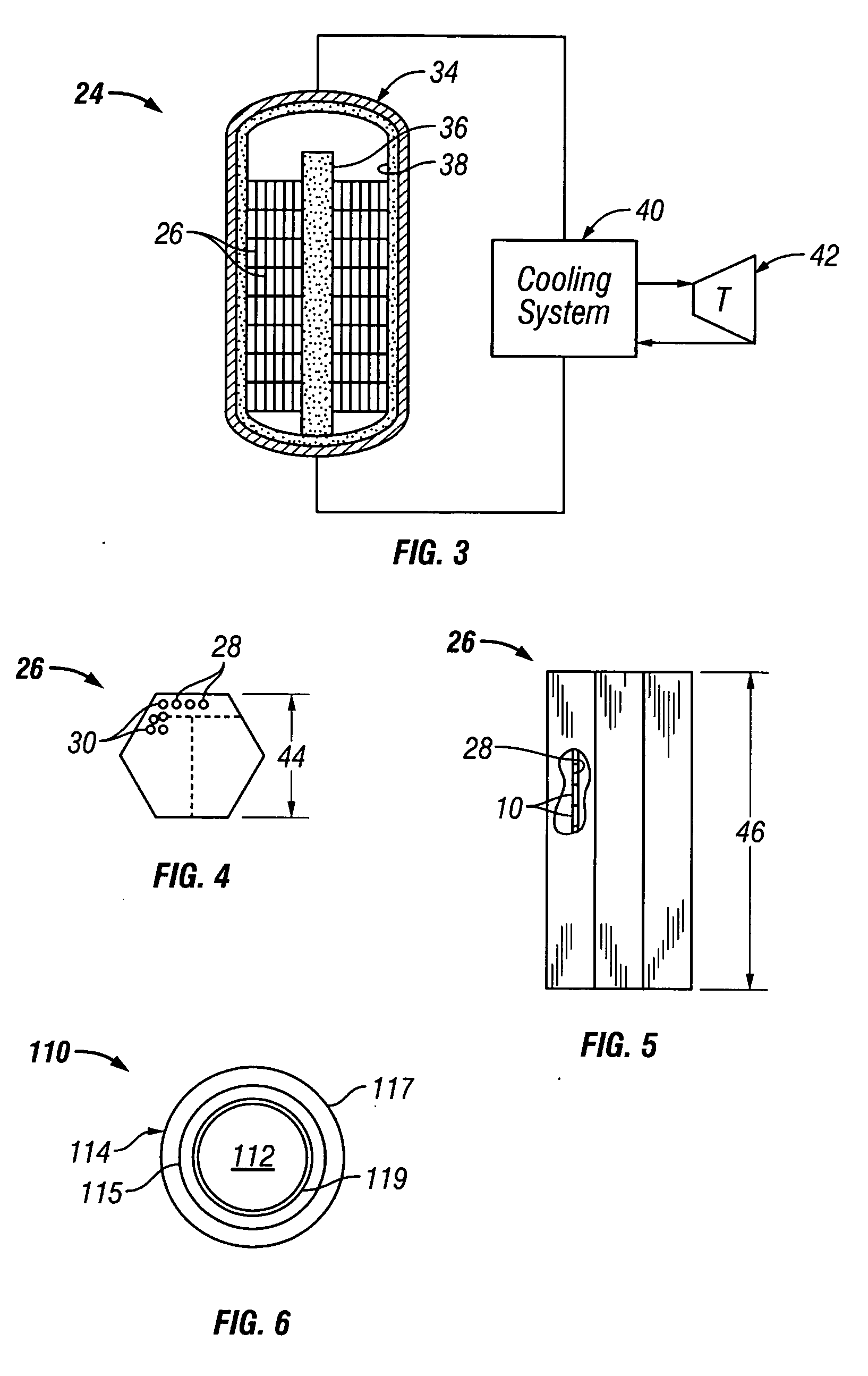High-density, solid solution nuclear fuel and fuel block utilizing same
a nuclear fuel and solid solution technology, applied in nuclear elements, reactor fuel susbtances, greenhouse gas reduction, etc., can solve the problems of limiting the total core power, limiting the current particle packing fraction in the fuel compact, and limiting the use of triso-coated particle fuel relative to the prismatic block vhtr core design
- Summary
- Abstract
- Description
- Claims
- Application Information
AI Technical Summary
Benefits of technology
Problems solved by technology
Method used
Image
Examples
example 1
[0053] The first burn-up calculation was for the initial VHTR core (554 g U-235 per block 26). For the TRISO-coated particle fuel case, the enrichment was 10.0 wt % U-235 with a particle packing fraction of 0.24715, UCO kernel size of 425 microns in diameter, UCO density of 10.50 g / cc, and a fuel rod diameter of 12.45 mm. For the UO2 fuel core 12 of the present invention, the enrichment was only 5.0 wt % with a diameter 18 of 3.06 mm. As mentioned, the core 12 was substantially encapsulated with a silicon carbide cladding 14 having a thickness 22 of about 1.5 mm. Thus, the overall diameter of the fuel element 10 was about 6.06 mm. The TRISO-coated particle fuel core goes subcritical at approximately 560 EFPD (Effective Full Power Day at 600 MWth total core power) and the core utilizing the fuel element 10 of the present invention at 630 EFPD. Use of the fuel element 10 of the present invention achieves a substantial increase of 70 EFPDs (13% increase). The important point here is th...
example 2
[0054] The second burn-up calculation was for a uniform core loading of reload blocks (776 g U-235 per block 26). In actual practice, only half of the core 34 would be reloaded in order to meet the 18-month power cycle goal. However for calculation purposes and one-to-one burn-up comparison the entire core 34 (i.e., 1020 fuel blocks 26) contained the 776 g U-235 loading. For the TRISO-coated particle fuel case, the enrichment was 14.0 wt % U-235 with a particle packing fraction of 0.24715, UCO kernel size of 425 microns in diameter, UCO density of 10.50 g / cc, and a fuel rod diameter of 12.45 mm. For the fuel core 12 (comprising UO2) of the present invention, the enrichment was again only 5.0 wt % with a core diameter 18 of 3.63 mm. Thus, including a cladding 14 having a thickness 22 of about 1.5 mm, the overall diameter of the fuel element 10 was about 6.63 mm. The reactor core with TRISO-coated particle fuel goes subcritical after approximately 890 EFPDs (Effective Full Power Day a...
example 3
[0055] The third burn-up calculation is essentially identical to the second burn-up calculation, except the enrichment of the UO2 fuel element 10 of the present invention is now increased slightly from 5.0 to 6.0 wt % and the diameter 18 of core 12 (e.g., comprising UO2) was diameter decreased slightly from 3.63 mm to 3.31 mm in order maintain the 776 g U-235 loading per fuel block 26. The increased enrichment is an attempt to extend the EFPD burn-up to better match the calculated TRISO-coated particle fuel core burn-up. As before, the TRISO-coated particle fuel core goes subcritical after approximately 890 EFPDs and the reactor core utilizing the fuel element 10 of the present invention now after 915 EFPD. For a one percent increase in the UO2 core enrichment, the burn-up is increased by 100 EFPDs and is now longer than the TRISO-coated particle fuel core by 25 EFPDs.
[0056] It is quite apparent that reactor cores utilizing the fuel elements described herein are superior to the TRI...
PUM
 Login to View More
Login to View More Abstract
Description
Claims
Application Information
 Login to View More
Login to View More - R&D
- Intellectual Property
- Life Sciences
- Materials
- Tech Scout
- Unparalleled Data Quality
- Higher Quality Content
- 60% Fewer Hallucinations
Browse by: Latest US Patents, China's latest patents, Technical Efficacy Thesaurus, Application Domain, Technology Topic, Popular Technical Reports.
© 2025 PatSnap. All rights reserved.Legal|Privacy policy|Modern Slavery Act Transparency Statement|Sitemap|About US| Contact US: help@patsnap.com



